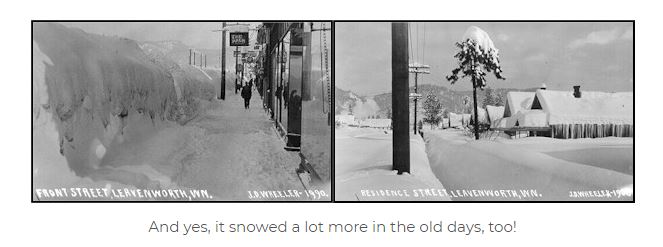Leavenworth Washington, a Brief History
Throughout the years Leavenworth Washington had to change and adapt in order to survive. Long before white settlers ventured into the American West, the Wenatchi Indians inhabited the Wenatchee Valley from Steven’s Pass to the Columbia River and present-day Wenatchee. But the great Pacific Northwest beckoned explorers, trappers and a few settlers who entered the area in the early 1800’s. By the mid-1800’s settlers were flooding into the area, and by the end of the century the Wenatchi Indians were all but gone. In the early 1880’s homesteaders staked claims about 10 miles east of Leavenworth near present-day Cashmere, then known as Mission. Leavenworth, originally known as Icicle, started out in 1885 when a small group of homesteaders settled where the Wenatchee and Icicle Rivers meet in the Leavenworth Valley. Known as Icicle Flats, it was the site of a Wenatchi Indian salmon fishery. By the 1890’s settlers were also moving up the Chumstick Valley and around Lake Wenatchee and Plain, then called Beaver Valley. 
As in all parts of this fledgling country, the railroads brought great change and growth. The Great Northern Railroad began laying track up the Wenatchee Valley in 1892 along what is now Highway 2, and over Steven’s Pass in 1893, transiting the Cascade Mountains. They constructed a roundhouse, switchyard and division headquarters in Leavenworth, making it an important rail head. But railroad history shows this was a tough and dangerous endeavor, and the Pacific Northwest would not be tamed easily. About 30 miles west of Leavenworth is Stevens Pass and the 8-mile Cascade Train Tunnel, and nearby the site of the original tunnel and the March 1, 1910 Wellington Train Disaster, one of the nation’s worst train disasters.
The town was platted in 1893 by the Okanogan Investment Company, and named for its president Captain Charles Leavenworth. The population at this time was around 700. A dam was constructed in 1904 at the south edge of town on the Wenatchee River to form a mill pond, and the Lamb-Davis Lumber Company built a large sawmill. The town was incorporated in April 1906. In the early 1900’s the first fruit trees were planted, and miles of irrigation canals were constructed developing Leavenworth’s agricultural base. Logging and fruit agriculture are still important industries today.
The triple-industry economy was very prosperous, and Leavenworth became a boom town with a questionable reputation. Its population rose to around 5,500 (today it’s about 2,100) and it boasted numerous brothels, and even more saloons. However, the good fortune crashed as fast as the stock market. In the 1920s the two biggest sources of revenue disappeared almost overnight. In 1922 the Great Northern Railroad moved its roundhouse and headquarters to Wenatchee, and rerouted the rail line from the steep and dangerous Tumwater Canyon to the Chumstick Valley, by-passing Leavenworth. With no easy access to the railroad, the sawmill closed in 1926 and the lumber company headed for more profitable areas. With the stock market crash of 1929 and the Great Depression of the 1930’s, followed by the war years, Leavenworth’s economy spiraled downward.

These hard times plagued Leavenworth through the 1940s and 1950s. With little hope of an economic rebound, stores were closing and people were leaving as there were few job opportunities. However, in 1962 community leaders approached the University of Washington Bureau of Community Development looking for ways to save the town. Out of this work came the idea to use the towns’ beautiful natural surroundings and a Bavarian theme to attract visitors to the area. Two of the leaders instrumental in this effort were Pauline and Owen Watson, longtime residents of Leavenworth who owned and operated Alpine Electric out of one of the buildings on Front Street.
In 1965 the decision was made by key business owners to adopt the Bavarian theme and remodel their buildings. Pauline created sketches of some of the storefronts and presented these ideas to other business owners. Her families’ Alpen Haus Gifts store is shown below. An agreement was reached and Project Alpine was formed to guide the Bavarianization of Leavenworth, with Pauline serving as chairperson for over ten years. In the summer of 1965, Alpine Electric was the first building to be remodeled into Alpine Electric and the Alpen Haus Gift Shoppe, shown below.

One of the most impressive facts about this entire project is that it was financed with private money – no federal assistance at all. Simply dedicated people mortgaging everything they had! The town underwent an amazing transformation. The first six buildings were remodeled in 1965 and 1966, and the others soon followed. Autumn Leaf Festival and the Christmas Lighting were introduced in the mid 1960’s, and the Maifest in 1971. Art in the Park and Amberleaf Theater began soon after, and Leavenworth was on its way to what you see today – a premier destination for family vacations, holidays, recreation and getaways.


